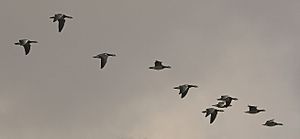
Back Migrasie van voëls Afrikaans هجرة الطيور Arabic Migración de les aves AST Quşların miqrasiyası Azerbaijani Ҡоштарҙың миграцияһы Bashkir Миграция на птиците Bulgarian পাখি পরিযান Bengali/Bangla Ptice selice BS Ocell migrador Catalan Migrace ptáků Czech


Bird migration is birds’ regular and annual seasonal journey between their breeding and wintering grounds.[1] Birds that migrate usually travel along north and south flyways and often fly vast distances. Animal migration is inherently risky.[1]
The Arctic tern holds the long-distance migration record for birds, travelling between Arctic breeding grounds and the Antarctic each year.[1] Some species of tubenoses, such as albatrosses, circle the Earth, flying over the southern oceans, while others such as Manx shearwaters migrate 14,000 km (8,700 mi) between their northern breeding grounds and the southern ocean. Shorter migrations are common, while longer ones are not. The shorter migrations include altitudinal migrations on mountains such as the Andes and Himalayas.
The timing of migration seems to be controlled primarily by changes in day length. Migrating birds navigate using celestial cues from the Sun and stars, the Earth's magnetic field, and mental maps.[1]
- ^ a b c d "What Is Bird Migration? Fascinating Facts Uncovered (2024)". Birds at First Sight. Tudor Studios LLC which owns and operates Birds at First Sight. Retrieved 7 June 2024.
© MMXXIII Rich X Search. We shall prevail. All rights reserved. Rich X Search